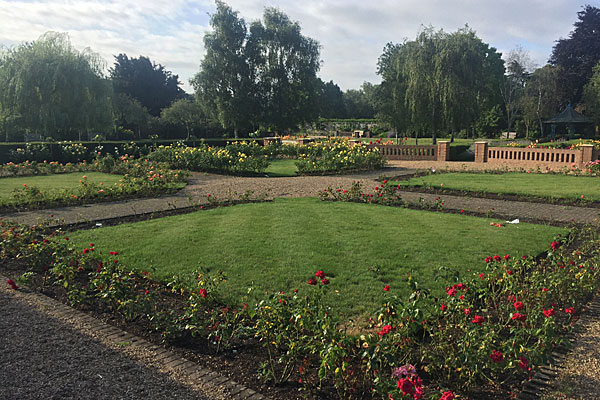The options for ashes after a cremation
For all cremation funerals, there is the question of what to do with the ashes (officially termed cremated remains). There are many options, so here we will cover off the most common ones.
Scatter ashes at Crematorium
The simplest option is to ask for the crematorium to scatter the ashes in their memorial garden. This is done by the crematorium staff and you can opt to attend the scattering or request for them to be scattered unwitnessed. This decision is specified in the official cremation application form.

Do bear in mind that the ashes will be scattered within days of the cremation, so if you are at all unsure, you can choose to delay this decision until you are certain of what you would like.
Retaining ashes at home
Should you decide to retain the ashes after the cremation, these will be provided by the crematorium in a sealed bag inside a cardboard box. Some crematoriums, such as Mortlake Crematorium, have a nicely designed cardboard presentation box, but most will just provide a simple cardboard box.

You could perfectly well keep the ashes in the original box from the crematorium until you have decided on what you would like to do with them. Alternatively you may wish to obtain an urn for ashes, especially if you would like to have them on display in your home. There are many types of urn available, made from all sorts of materials – from brass and metal to biodegradable materials. There are also urns that can be placed in your own garden and taken with you should you move home (view our selection of urns).
If you wish to keep just a small quantity of ashes inside a piece of special jewellery, there are also many options for ashes jewellery available. The amount of ashes used for jewellery is minimal, so there will still be nearly a full set of ashes remaining.
If you intend to take the ashes abroad, we recommend that you retain them in the original container provided by the crematorium (see our guide to transporting ashes abroad).
Interment of ashes
Ultimately many families will want to find a final resting place for the ashes of their family member, either in a burial ground or in nature, often choosing a location that has a special meaning to them.
When ashes are formally buried, this is termed an ashes interment. Ashes can be interred or scattered at a natural burial ground (pictured here).

Traditional cemeteries provide the option of interring the ashes in a grave. You can use an existing family plot or purchase a specific grave for ashes (in the cremated remains section). The advantage of this is that a gravestone or plaque will mark the place where the ashes have been interred.
Locations where ashes can be buried or interred
Here are some example locations:
Cremated Remains Grave at Teddington Cemetery:
- Grave purchase fee: £1,894
- Interment fee: £462
- Total: £2,356
Ashes interment at GreenAcres Chiltern Natural Burial Ground:
- 10 year lease for Acorn Glade: £640
- Interment fee: £325
- Total: £965
Columbarium
The alternative offered by cemeteries and most crematoria is to keep ashes in a columbarium. A columbarium is a free-standing memorial unit or wall, with individual chambers or niches marked with a memorial plaque which will accommodate one or two sets of ashes. This is not a permanent resting place, they are leased for a period of time (10 years or more), so are often chosen by families when a final resting place has yet to be determined.
For a columbarium, here are some examples:
Niche at Mortlake Crematorium:
- Grant of Exclusive Right to Deposit up to 2 urns in a niche (10 years): £2,000
- Opening of a niche and inscription: £600
- Total: £2,600
Orchid Columbarium at Teddington Cemetery:
- Purchase fee: £1,397
- Columbarium Plaque: £277
- Total: £1,674
Scattering or releasing ashes in nature
A popular option is to scatter the ashes in one or more locations, particularly in places that have a special meaning to the family. This can be a no-cost option.
Ashes can be released into rivers, lakes or the sea. Avoid areas near where there may be swimmers. We recommend using a special biodegradable water urn (see urn options for scattering on water) which will avoid the risk of ashes being disrupted by winds. These can gently float for a few minutes before slowly sinking, creating a ceremonial feeling.
Ashes can also be scattered on land. There are very few rules about where ashes can be scattered, however on private land the landowners permission should be sought and the use of national parks is not permitted. Due to the quantity of ashes, it is recommended that you either bury the ashes in a biodegradable container (see urn options for scattering on land) or rake the ground and spread them over a larger area, rather than depositing them in one place (for this, you may wish to use a scatter tube to disperse the ashes).
Certain natural burial grounds will also offer the option of having ashes scattered there. For example, at GreenAcres Chiltern this can be provided from £250. At Kew Gardens, a personal ashes scattering service can be held for a suggested donation of £500.
Prices above correct as at December 2021. If you have any questions about this topic, please feel free to call White Rose Modern Funerals on 020 3281 1045 or visit the website scattering-ashes.co.uk

We’re here to help
If you have any questions regarding arranging a funeral or planning ahead, please get in touch. Call us on 020 3281 1045 or send us a message.
Independent funeral director
helping families across London & Surrey
You can speak to us anytime on 020 3281 1045 – we’re open 24/7
